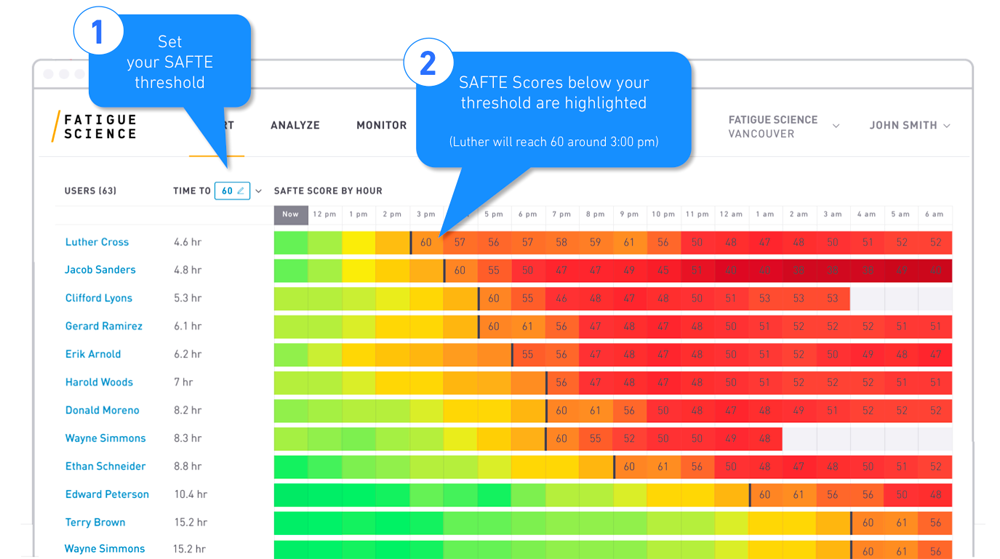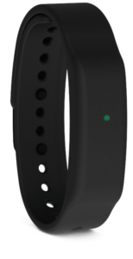Frequently Asked Questions
General Questions
What is Fatigue Science?
Fatigue Science is a leading provider of predictive fatigue management solutions. We use AI and machine learning technology to help industries manage and mitigate fatigue-related risks, enhancing worker safety and productivity.
What is the Readi platform?
Readi is our fatigue risk management system. It uses advanced algorithms to predict fatigue levels, providing real-time insights to help organizations make informed decisions about workforce management.
Technology and Implementation
How does Readi predict fatigue?
Readi uses AI, machine learning, and biomathematical modeling to analyze data such as work schedules and sleep patterns, predicting fatigue levels with high accuracy.
Does Readi require wearable devices?
No, Readi can function without wearables, using existing operational data. However, it can integrate with wearable devices, such as our ReadiWatch and some Fitbit and Garmin watches, for increased accuracy.
How long does it take to implement Readi?
Implementation time varies, but typically takes 2-3 weeks for basic setup. Our team works closely with you to ensure a smooth integration process. See our Professional Services.
How easy is it to integrate Readi into our existing systems?
We've designed Readi for seamless integration. Typically, implementation takes only 2-3 weeks. Readi integrates into most mining software, fleet management systems, time and attendance software, and in-cab camera software without requiring extra screens or additional work from your team.
Our experienced team handles all aspects of integration, minimizing the burden on your IT department.
Benefits and ROI and Readi
How does Readi improve safety?
By predicting fatigue levels in advance, Readi allows organizations to take proactive measures to prevent fatigue-related incidents, significantly enhancing workplace safety.
Can Readi help improve productivity?
Yes, by optimizing schedules and task assignments based on predicted fatigue levels, Readi can help improve overall productivity and operational efficiency.
Is there evidence of Readi's effectiveness?
Yes, our clients have reported significant improvements in safety metrics and productivity. See our case studies section for more information.
What kind of return on investment (ROI) can we expect from implementing Readi?
Our clients typically see a significant ROI in terms of productivity gains and reduction in safety-related costs. To put it in perspective, Readi is often less expensive than a single workers' compensation claim or the cost of replacing a haul truck after an incident. The exact ROI can vary depending on your specific operations, but our team can help you calculate potential savings for your organization. Read the ROI of Readi whitepaper to learn more.
Pricing and Contracts
How much does Readi cost?
Our Readi software is offered on a subscription basis. Pricing depends on the scale of implementation, the number of ReadiWatches required, and the specific needs of your organization. Visit our pricing page for more information.
Can we try Readi before committing?
Yes, we offer pilot programs that allow you to experience the benefits of Readi in your specific operational environment before full implementation. Pilot lengths can vary but typically last approximately 3 months.
Support and Training
What kind of support does Fatigue Science offer?
We offer comprehensive support, including professional services, implementation assistance, training, and ongoing technical support. Our team is dedicated to ensuring your success with our technology.
Is training provided for using Readi?
Yes, we provide thorough training for all levels of users, from operators to administrators, ensuring everyone can effectively use and benefit from the platform.
How do you ensure adoption of Readi across our organization?
We understand that implementing a new system can be challenging. That's why we offer comprehensive change management support. Our team works with you to ensure smooth adoption across all levels of your organization, from operators to supervisors to health and safety teams. We provide tailored training, ongoing support, and strategies to demonstrate the value of predictive fatigue management to all stakeholders.
Will implementing Readi disrupt our current operations?
Readi is designed to enhance your operations with minimal disruption. Our phased implementation approach allows for a smooth transition. Most of our clients find that Readi quickly becomes an integral part of their operations, improving processes rather than disrupting them.
The SAFTE™ Fatigue Model
What is the SAFTE Fatigue Model?
The SAFTE Fatigue Model is a biomathematical analytical model. When the SAFTE Fatigue Model is given accurate sleep data, it can measure, quantify and predict human fatigue impairment. It was developed by the Walter Reed Army Institute of Research at the U.S. Army Medical Research Development Command, and stands for: Sleep, Activity, Fatigue and Task Effectiveness. Learn more about the science of sleep here.
How has the SAFTE Fatigue Model been validated and proven in real-world applications?
The SAFTE Fatigue Model has been extensively validated and used by various departments of the US military and government. It has also undergone several clinical trials. Research validating the SAFTE Fatigue Model can be found here.
How does the SAFTE Fatigue Model reveal who is most fatigued?
The SAFTE Fatigue Model comes to life in the Fatigue Science web app, an easy-to-use, at-a-glance secure web application that graphically shows authorized risk managers and coaches who is currently fatigue-impaired, as well as who will become fatigue-impaired over the hours of the upcoming day ahead. With the Fatigue Science Predictive Fatigue Management Solution, managers can also view historical sleep and fatigue trend data for filtered groups or selected individuals, or in aggregate across their workforce.

Does the SAFTE Fatigue Model consider napping?
Yes, all periods detected as sleep periods are factored into the SAFTE Fatigue Model’s sleep algorithm, and will have a corresponding effect on a person’s SAFTE Alertness Score.
Can the SAFTE Fatigue Model identify sleep disorders such as sleep apnea?
The Fatigue Science Predictive Fatigue Management Solution is not intended to provide a formal medical diagnosis of sleep disorders such as sleep apnea. However, insights from our platform can provide a useful “pre-screening” function to many organizations, helping to provide insight not only into the most chronically fatigued individuals among a larger population, but possible indicators of likely sleep abnormalities (such as high sleep latency or heavily interrupted sleep).
With this information, our platform makes it easy for organizations not only to help steer their most chronically fatigued workers to treatment and guidance, but also to monitor for improvements and degradations in conditions over time.
What is FAST?
FAST, or the Fatigue Avoidance Scheduling Tool, is a desktop software application that helps risk managers plan out schedules based on the sleep opportunity that they afford — using the SAFTE Fatigue Model to simulate the likely impact of these schedules on fatigue exposure, and determining optimal timing and conditions for work and rest.
FAST is used extensively by the US military, global aviation firms, and many other industrial organizations. Learn more here.
ReadiWatch (formerly ReadiBand™) Wearable Device
What is the ReadiWatch (ReadiBand)?
 The ReadiWatch (ReadiBand) is a small, wrist-worn wearable device that measures sleep via actigraphy — high-frequency accelerometry sampling of the movement of the wrist.
The ReadiWatch (ReadiBand) is a small, wrist-worn wearable device that measures sleep via actigraphy — high-frequency accelerometry sampling of the movement of the wrist.
It has been validated against clinical sleep labs (polysomnography) at 92% accuracy for sleep/wake detection — far exceeding the measurement accuracy available from a consumer-grade device.
The ReadiBand uses Bluetooth to transmit collected sleep data to authorized mobile devices, which pass this data to the SAFTE Fatigue Model for analysis in our secure cloud platform. Learn more about the validation behind the ReadiBand here.
What does the ReadiWatch (ReadiBand )track?
The ReadiWatch (ReadiBand) only tracks actigraphy — body motion — to determine the quantity and quality of a person’s sleep. For data privacy reasons, the ReadiWatch (ReadiBand) intentionally does not track a person’s location (no GPS), or other biometrics such as heart rate, stress or temperature.
How does the ReadiWatch (ReadiBand) differ from consumer fitness trackers?
Consumer-grade fitness trackers provide some insight into fitness metrics like GPS location, steps, and distance walked, and in some cases sleep. However, consumer grade devices are not validated in their accuracy of sleep capture, and often miss or underestimate critical nuances such as acute wake episodes, which have a material impact on one’s fatigue.
The ReadiWatch (ReadiBand) has been validated against clinical sleep labs (polysomnography) at 92% accuracy for sleep/wake detection — far exceeding anything available from a consumer device.
More importantly, accurate sleep data collection is only half the equation. The other critical question is: is one’s pattern of sleep truly restorative, or is an individual facing reduced performance due to fatigue? Only with the SAFTE Fatigue Model paired with the ReadiWatch (ReadiBand) are these insights available from sleep data.
Does the ReadiWatch (ReadiBand) have to be worn continuously?
For the most accurate results, the ReadiWatch (ReadiBand) should be worn continuously, in order to ensure capturing of any periods such as naps. However, brief periods of non-use (such as an hour or two) will not affect the ReadiBand’s overall accuracy unless a period of sleep is missed during that period. For instance, athletes will often remove their ReadiBands during training or game time.
How is the ReadiBand charged?
When it needs to be recharged, the ReadiWatch (ReadiBand) can simply be plugged into a computer’s USB port, or using a standard USB wall charger.
Fatigue Science in use
What sleep data is collected?
The ReadiBand only tracks actigraphy — body motion — to determine the quantity and quality of a person’s sleep. For data privacy purposes, the ReadiBand intentionally does not track a person’s location (no GPS), or other biometrics such as heart rate, stress or temperature.
Who can see personal sleep data?
Only managers / coaches expressly authorized by the organization are able to see individual sleep data.
Can ReadiBand wearers see their own sleep data?
 Yes, we believe that for sleep, fatigue and performance management to be successful, ReadiBand wearers should be involved in monitoring their own sleep health.
Yes, we believe that for sleep, fatigue and performance management to be successful, ReadiBand wearers should be involved in monitoring their own sleep health.
With our ReadiBand app, users can easily see their current and predicted SAFTE Alertness Scores, their most recent sleep, and their sleep over the last 7 days.
Can managers or coaches see sleep data remotely?
Only if a company or team’s Readiband program has been configured to permit access.
Many programs are implemented for purely “self-management,” i.e. with no access provided to coaches or management, while other programs use certain management tools to provide closer assistance to players and workers. You will know when your program is launched if your organization’s personnel have been provisioned access to your data.
How is personal sleep data kept secure?
Our data centers are secured and monitored 24/7/365, with interior/exterior surveillance and access limited to authorized personnel. Web and API traffic is transmitted over HTTPS (TLS 1.2). Sensitive data is stored behind a DMZ, and all passwords are encrypted using industry best practices.
How does Readi address union concerns and employee privacy?
Readi is designed with privacy and union regulations in mind. Our system doesn't require wearables or employee tracking, and it doesn't implement punitive countermeasures.
Still have questions? We're here to help!
If you couldn't find the answer you were looking for, please don't hesitate to reach out. Our team of fatigue management experts is always ready to assist you.
Sales inquiries: sales@fatiguescience.com
Technical support: help@fatiguescience.com
